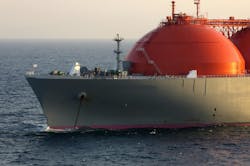WoodMac: Rising LNG prices to curb Asian demand, boost European gas storage levels
European gas storage is predicted to reach full capacity by end-September and remain full until end-October, with an additional 4 million tonnes/year (tpy) of floating storage accumulated, according to a Wood Mackenzie report.
Low European demand for gas has kept storage levels at record highs this year, despite Europe importing 11-million tpy less LNG through May compared with teh same period in 2023, Wood Mac said.
"Lower European demand has depressed prices and pushed LNG into Asia with imports to China alone up 22%," said Lucy Cullen, director of EMEA (Europe, Middle East, and Africa) gas and LNG research, Wood Mackenzie. "Looking ahead, high prices are likely to provide some headwinds to near-term Asian demand growth. As a result, European storage levels remain on track to reach full capacity by the end of September and stay that way through October."
The increased Asian demand, alongside risks to Russian supply and maintenance at Norwegian fields, has pushed European gas prices higher with the Title Transfer Facility (TTF) price up 40% over the last 3 months and trading close to $11/MMbtu, Cullen said.
European demand improving in mid-term
A return to normal weather dynamics over the winter of 2024-2025 and a strengthening macroeconomic outlook will lead to higher heating requirements, industrial activity, and electricity demand across Europe, the report said.
Overall, WoodMac anticipates an increase in gas demand of 7 bcm in 2025 compared with 2024. Meanwhile, rising Asian demand will absorb most of the yet limited new LNG coming online, but Europe should manage to import an extra 4.2-million tpy in 2025 compared with 2024.
However, the report adds that Europe will most likely lose more Russian volumes, up to 12 bcmy as the transit agreement via Ukraine expires on Jan. 1, 2025. Central European markets will look for alternatives to bolster supply, including boosting use of LNG regasification capacity in Southeast Europe.
Supply risks remain
The report states that the greatest supply risks come from Russian gas supply whether this be via an early cut of transmission via Ukraine or as a consequence of pending arbitration proceedings between European energy companies and Gazprom.
Additionally, unplanned or extended maintenance in Norway will play a more significant role as Norway is now Europe’s biggest gas supplier. The speed at which new North American LNG supply reaches the market also remains a crucial concern.
Wave of new global LNG supply
With over 40-million tpy of LNG supply growth anticipated in 2026, prices are expected to undergo a structural shift. Asian LNG demand will absorb significant additional LNG supply, but Europe will have to absorb almost 20 million tonnes of additional LNG in 2026, putting downward pressure on prices.
"European storage levels will once again reach record levels, despite resilient gas demand and reduction in pipe imports from Norway," Cullen added. "But with the level of LNG imports in Europe only marginally higher than peak 2022 import levels, our view is that the coming wave of LNG supply will somehow be absorbed, with European prices holding close to $8/MMbtu. The risk that US LNG cancellation will be needed to balance the market remains limited."
"Many risks remain for the price outlook of 2026," Cullen said. "A muted demand response to lower prices across Asia would add further pressure on prices. Meanwhile, supply risks can't be ruled out, with an anticipated escalation of Western sanctions on Russian LNG limiting supply growth, increasing the risk of a stronger-for-longer market."

